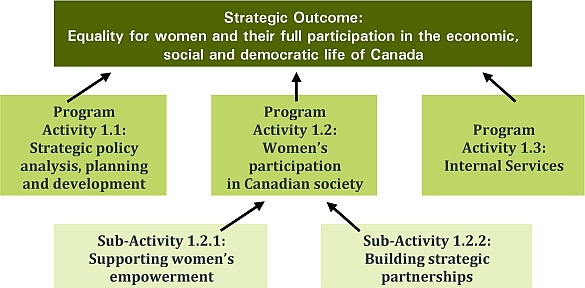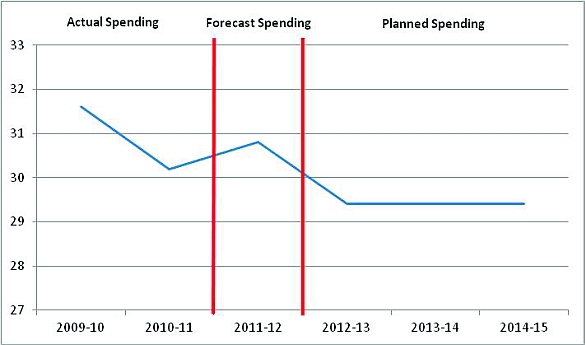Common menu bar links
Breadcrumb Trail
ARCHIVED - Status of Women Canada - Report
 This page has been archived.
This page has been archived.
Archived Content
Information identified as archived on the Web is for reference, research or recordkeeping purposes. It has not been altered or updated after the date of archiving. Web pages that are archived on the Web are not subject to the Government of Canada Web Standards. As per the Communications Policy of the Government of Canada, you can request alternate formats on the "Contact Us" page.
Minister’s Message
 Women in Canada today are taking on new challenges, overcoming barriers and stepping into leadership roles. They can be powerful agents of change in their families and their communities, inspiring and opening the doors of opportunity to girls and young women.
Women in Canada today are taking on new challenges, overcoming barriers and stepping into leadership roles. They can be powerful agents of change in their families and their communities, inspiring and opening the doors of opportunity to girls and young women.
Thanks to Canada’s leadership in helping to establish the United Nations International Day of the Girl, Canada and the world will celebrate this unique commemoration for the first time on October 11, 2012. As we plan for another year of progress, the Government of Canada remains committed to improving the status of women and girls, and to advancing their full participation in the life of our country.
Our government, through Status of Women Canada, will remain focused on three priority areas: eliminating violence against women and girls; strengthening women’s and girls’ economic security and prosperity; and encouraging women’s leadership and decision-making roles.
The Women’s Program of Status of Women Canada is now building on the demonstrated success of its support for projects that have been effective in responding to the needs of Canadians, and meeting our priorities for women and girls. The Program’s targeted calls for proposals, implemented last year, have also been highly successful. We will continue to issue targeted calls, which allow the Government of Canada, through Status of Women Canada, to respond to new and emerging issues.
Status of Women Canada continues to play a leading role in the sustainable implementation of gender-based analysis and will continue to support federal organizations to use this key lever for advancing gender equality through decision-making processes of government.
As Minister for Status of Women, I am honoured to present Status of Women Canada’s 2012–2013 Report on Plans and Priorities.
Rona Ambrose, P.C., M.P.
Minister of Public Works and Government Services and
Minister for Status of Women
Section I: Organizational Overview
Raison d’être
The Office of the Co-ordinator, Status of Women, known as Status of Women Canada (SWC), is a federal government agency that promotes equality between women and men in all aspects of Canadian life. The mandate of SWC is “to coordinate policy with respect to the status of women and administer related programs” (1976).
SWC is responsible for exercising leadership and working in partnership to advance equality and increase women’s participation in the economic, social and democratic life of Canada and in supporting Canada’s efforts to meet international obligations; providing expert advice on how to take gender equality into account in developing the best policies and programs for all Canadians; promoting commemorative dates relating to women in Canada; and supporting action and innovation that will lead to equality in communities across Canada.
SWC works to advance equality for women, focusing its efforts in three priority areas: increasing women’s economic security and prosperity; ending violence against women and girls; and encouraging women’s leadership and decision-making roles.
The Office of the Co-ordinator, Status of Women is estimating expenditures of $29.4 million in 2012–2013. Of this amount, $28.2 million requires approval by Parliament. The remaining $1.2 million represents statutory forecasts that do not require additional approval and are provided for information purposes.
Responsibilities
SWC is the primary federal agency responsible for supporting the Government’s agenda to advance equality for women and girls. In fulfilling its mandate, the agency works with a wide range of organizations, building synergies with key stakeholders, collaborating with different levels of government and engaging the private and voluntary sectors.
SWC functions in a complex environment where women’s and girls’ issues permeate society. To bring about concrete results and enduring benefits for Canadians, the agency carries out its mandate strategically, working in partnerships, focusing its efforts where there is a clear potential for making a difference in the lives of Canadian women and girls, and ensuring its policy intervention and program investments are aligned with Government of Canada priorities. While SWC focuses on three priority areas, the agency is able to address issues specific to diverse groups, such as Aboriginal, immigrant and rural women and girls.
In its policy function, SWC plays the role of a knowledge broker and facilitator, offering advice and strategic support, conducting policy analysis, providing input and making strategic interventions at both domestic and international levels.
SWC also leads in building capacity for Gender-based Analysis (GBA). This term does not, in fact, adequately describe the actual analytical practice, which involves gender and other multiple aspects of identity. SWC will promote the modernization of GBA practice through the promotion of a gender and diversity approach known as Gender-based Analysis+ (GBA+), a method for examining the intersection of sex and gender with other identity factors. When applied to government work, GBA+ can aid in understanding how Canadian women and men experience public policy. SWC works in collaboration with key stakeholders to facilitate the consideration of gender dimensions in the development of policies and programs.
Through the Women’s Program, SWC provides financial and professional assistance to Canadian organizations to carry out projects that advance equality and the full participation of women and girls. SWC invests resources where there is a clear potential for making a difference in the lives of Canadian women and girls.
SWC’s regional offices are located in Montreal (serving Quebec), Moncton (serving New Brunswick, Prince Edward Island, Nova Scotia and Newfoundland and Labrador), and Edmonton (serving Alberta, Manitoba, Saskatchewan, British Columbia, Northwest Territories and Yukon). The National office, including Nunavut, and Ontario regional offices
are located within the headquarters in the National Capital Region. (http://www.swc-cfc.gc.ca)
Strategic Outcome and Program Activity Architecture (PAA)
Program Activity Architecture for 2012–2013

Program Activity Architecture for 2012–2013 - Text Version
Organizational Priorities
| Priority | Type | Strategic Outcome |
|---|---|---|
| Addressing violence against women and girls | Ongoing | Equality for women and their full participation in the economic, social and democratic life of Canada |
| Description | ||
|
Why is this a priority? Women and girls continue to be victimized at alarming rates. The 2011 Speech from the Throne demonstrates the Government’s commitment to address the problem of violence against women and girls. Plans for Meeting the Priority Strategic Interventions/Collaboration
Knowledge Brokering
|
||
| Priority | Type | Strategic Outcome |
| Empowering girls | New | Equality for women and their full participation in the economic, social and democratic life of Canada |
| Description | ||
|
Why is this a priority? The United Nations has declared October 11, 2012, as the world’s first International Day of the Girl. Canada, with support from non-governmental organization Plan Canada, led the international community in adopting this day. Plans for Meeting the Priority Strategic Interventions/Collaboration
Knowledge Brokering
|
||
| Priority | Type | Strategic Outcome |
| Increasing representation of women in leadership roles | Ongoing | Equality for women and their full participation in the economic, social and democratic life of Canada |
| Description | ||
|
Why is this a priority? Women continue to be under-represented in key decision making forums and venues. For example, women currently hold 15% of board seats in Financial Post 500 firms; and 40% of the Financial Post 500 firms have no women on their boards (source: 2011 Canadian Board Diversity Council Report Card). Women are under-represented in the political realm as well. For example, as of May 2011, only 16% of Canadian mayors and 25% of city councilors were women. Plans for Meeting the Priority Strategic Interventions/Collaboration
Knowledge Brokering
|
||
| Priority | Type | Strategic Outcome |
| Strengthening the implementation of gender-based analysis (GBA) in the federal administration | Ongoing | Equality for women and their full participation in the economic, social and democratic life of Canada |
| Description | ||
|
Why is this a priority? This is a priority to enable a growing number of organizations and actors to integrate GBA more systematically into their work and decision-making processes, including through the continued implementation of the Departmental Action Plan on Gender-Based Analysis. Plans for Meeting the Priority Strategic Interventions/Collaboration
Knowledge Brokering
|
||
| Priority | Type | Strategic Outcome |
| Modernizing programs and services for Canadians | New | Equality for women and their full participation in the economic, social and democratic life of Canada |
| Description | ||
|
Why is this a priority? Through continuous innovation and transformation, the agency ensures efficiency, accountability and effective allocation of resources to achieve results. Plans for Meeting the Priority
|
||
Risk Analysis
Planning Context
Canada continues to be a country where the foundation of equality for women and girls is strong. Data obtained from sources such as Women in Canada: A Gender-based Statistical Report (2010–2011) commissioned by SWC and 18 other federal organizations, and produced by Statistics Canada, shows steady progress toward equality for women and girls in Canada. It also shows areas where further progress is required, including but not limited to:
- Leadership: Canadian women are making great strides in leadership. For example, in 2009, women comprised 51.2% of business and financial professionals, up from 38.3% in 1987, and 31.6% of those in senior management, up from 21% in 1987. However, more work needs to be done to increase women’s representation in politics, where, for example, only 16% of
Canada’s mayors are women, and women hold only 14.5% of corporate board seats among Canada’s top 500 companies.
- Violence: There are signs of progress in addressing violence against women and girls, with a dramatic decrease in the rate of spousal homicide in which women are victims. In 2009, the rate was a third of the 1979 figure. However, statistics also show that continued efforts are needed to eliminate violence against women and girls. For example, women are
overwhelmingly the victims of sexual assault, compared to men.
- Wage Gap: Gaps remain, but progress is being made on closing the gender wage gap. Women now earn, on average, an hourly wage of almost 84 cents compared to every dollar earned by men (an increase of 8% since 1988).
Operating Environment
SWC continues to operate in a complex environment where advancing gender equality remains a shared responsibility both within and outside of the federal government. SWC faces the same challenges in delivering on horizontal files as any other small organization and needs to focus its efforts to
best serve Canadians. The agency has implemented a Corporate Risk Profile, as required, to address strategic risks and management priorities in keeping with its available resources.
Planning Summary
Budget 2010 announced measures to reduce the rate of growth in operating expenditures in an effort to restore balance to public finances over the next five years. As a result, 2012–2013 budgets will be frozen at 2010–2011 levels and organizations will not be funded for new wage increases. The impact of this freeze will be mitigated through targeted reductions in spending in various discretionary activities such as the use of temporary help services and reengineered processes.
| 2012–2013 | 2013–2014 | 2014–2015 |
|---|---|---|
| 29.4 | 29.4 | 29.4 |
| 2012–2013 | 2013–2014 | 2014–2015 |
|---|---|---|
| 94 | 94 | 94 |
| Strategic Outcome: Equality for women and their full participation in the economic, social and democratic life of Canada | |||||
|---|---|---|---|---|---|
| Program Activity | Forecast Spending 2011– 2012 |
Planned Spending | Alignment to Government of Canada Outcomes | ||
| 2012– 2013 |
2013– 2014 |
2014– 2015 |
|||
| Strategic policy analysis, planning and development | 2.0 | 1.8 | 1.8 | 1.8 | Government Affairs: A transparent, accountable, and responsive federal government. http://www.swc-cfc.gc.ca/abu-ans/index-eng.html |
| Women’s participation in Canadian society | 24.9 | 24.2 | 24.2 | 24.2 | Economic Affairs: Income security and employment for Canadians. http://www.swc-cfc.gc.ca/fun-fin/wcf-fcf/index-eng.html |
| Total Planned Spending | 26.0 | 26.0 | 26.0 | ||
| Program Activity | Forecast Spending 2011– 2012 |
Planned Spending | |||
| 2012– 2013 |
2013– 2014 |
2014– 2015 |
|||
| Internal Services | 3.9 | 3.4 | 3.4 | 3.4 | |
| Total Planned Spending | 3.4 | 3.4 | 3.4 | ||
| Priority | Type | Links to Strategic Objective | Description |
|---|---|---|---|
| Addressing violence against women and girls | Ongoing | Equality for women and their full participation in the economic, social and democratic life of Canada |
This priority addresses the fact that women and girls continue to be victims of violence at alarmingly high rates. |
| Empowering girls | New | Canada took the lead at the United Nations on establishing the International Day of the Girl. This priority seeks to enable girls and young women to be powerful voices of change in their families, their communities and their nations. | |
| Increasing representation of women in leadership roles | Ongoing | This priority addresses the under-representation of women in key decision-making forums and venues. | |
| Strengthening the implementation of gender-based analysis (GBA) in the federal administration | Ongoing | This priority seeks to enable a growing number of organizations and actors to integrate GBA into their work and their decision-making processes. | |
| Modernizing programs and services for Canadians | New | This priority stresses continuous innovation and transformation of SWC’s programs and services to ensure they are well managed and accountable and that resources are allocated to achieve results. |
Expenditure Profile
Actual spending from 2009–2010 to 2010–2011 includes all Parliamentary appropriations: Main Estimates, Supplementary Estimates and transfers from Treasury Board such as the operating budget carry-forward adjustment.
- 2009–2010 actual spending was at its highest due to re-profiled transfer payment funding from 2008–2009.
- 2011–2012 forecast spending has increased compared to 2010–2011, mostly due to severance payments requested by employees as per renegotiated collective agreements.
- For the period 2012–2013 to 2014–2015, total spending corresponds to planned spending. At this point, supplementary funding remains unknown.
Departmental Spending Trend ($ millions)

Departmental Spending Trend ($ millions) - Text Version
Estimates by Vote
Estimates by Vote are presented in the 2012–2013 Main Estimates, which are available at: http://www.tbs-sct.gc.ca/est-pre/index-eng.asp.
